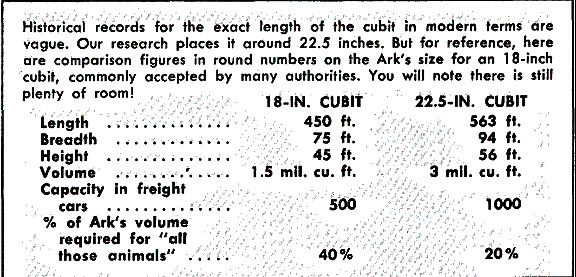
Save the earths fauna in an Ark? Only the most simplistic Bible-believer would swallow a tale so incredibly naive! Any seaman worth his salt knows Noah would have had more animals than he could ever hope to carry in his comical floating tub! So goes the critics sarcastic carping and ridicule of the sober Bible record of the flood of Noahs time. Let's look at the facts - well quickly see that the critics are all wet! Critics of the Bible usually flourish in the rich soil of misconception. Traditional images and popular literature picture the Ark scarcely larger than an ordinary fishing smack- sitting helpless before the slightest squall.
Now let's find out what the truth is - and why all those animals had room to spare!
First consider the real size of the Ark. The length of the ark shall be three hundred cubits {563 ft.}, the breadth of it fifty cubits [94 ft.], and the height of it thirty cubits [56 ft.) (Genesis 6:15). That's ocean-liner size! Not until the nineteenth century was there built a vessel that exceeded its length. On displacement standards the Ark was a ship of 66,000 tons.
It had a volume of about three million cubic feet (and virtually the entire capacity of the Ark could be used for storage). This is equal in capacity to somewhat in excess of 1000 standard American railroad freight cars !
The surprising similarity of the Ark to modern ships is vividly demonstrated by a class of vessels which do a job remarkably like that of the Ark ... Lightships. Situated at strategic locations along the coasts of many countries, where fixed lighthouses are difficult to construct, is an ever-present battery of lightships. As did the Ark, these maritime sentinels ride steady in heavy seas without the aid of engines, Their hulls contain accommodation for the crew, generators to power the powerful electric lights, fog horns and radio transmitters. They are towed into position for use. Illustrated is a representative member of the class. It is the Soath Goodwin lightship which stands guard over the ever-changing sands of the River Thames, a few miles off the southeast coast of England. This modern ark has virtually the identical overall shape of Noah's Ark. The real Ark was, of course, several times as large in all dimensions. Just for interest, consider the weight of the Ark. A meager knowledge of ship construction will reveal that a ship of that size would require a very large single central rib, or keel, just to support the sheer weight of materials alone. One can build a tiny vessel using basketweaving techniques, but not a giant liner. The framework of the Ark alone must have been an engineering masterpiece - laminated out of many skillfully selected and precision-planed separate pieces. We must recognize the existence of skilled knowledge and ability in that ancient world not again equaled until recent times ! After all, what about the men who built the Ark - Noah and his family?
What were they like? It took a man with sufficient mind power, resources and experience - and backed by God's power - to carry out the monumental task of saving mankind from total destruction in a worldwide flood! It took more than a local incompetent to warn the world of impending disaster! And Noah must have been capable of managing great wealth to finance the cost of building the Ark. Obviously, no accurate figures can be given, but an estimate is available in terms of modern ships of similar size.

In 1968, Upper Clyde Shipbuilders Ltd. of Scotland completed a large utility bulk carrier 550 feet in length, 75feet wide and 47 feet high, a size somewhat smaller than the Ark. Complete with engine and one deck, but without fittings, the ship cost f1,500,000 (about $4,000,000). No matter what the comparative costs were in Noah's day, the Ark required colossal resources to construct. It was hardly the backyard effort of a primitive river-dweller.
Now how did Noah get all those animals into the Ark?
First of all, God specifically instructed Noah to select one pair of every KIND (seven pairs of clean animals). The Bible term kind refers generally to a group of creatures, all of which interbreed. The horse kind is represented, therefore, by one pair of animals, and the same would be true also for dogs, cats, etc...
Then by noticing Genesis 7:22, All in whose nostrils was the breath of life, it is clear that only air breathing terrestrial animals were included in the Ark. This excludes virtually all sea creatures and simple forms of life which are not harmed by water.
Now consider this. 60% of the animal kingdom lives in the sea... and 70% of all land animals are insects... The remaining 12% of the animal kingdom are of average size of a rhesus monkey.
Remember the ark had a storage capacity of 1000 freight cars... Giving every pair of known modern species of insects 16 cubic inches of space, only 21 such freight cars would be required. (Counting Genesis kinds only, the required space is far less.)
For the other creatures we wrote a letter to the London Zoo for information on how much space animals require. The answer was, Most animals can be maintained in very close confinement indeed for long periods and remain perfectly healthy. A rhesus monkey, say, can be maintained indefinitely in a cage about 2 ft., 6 inches cubed (15 cubic feet).
Accurate estimates of the number of mammal, bird reptile and amphibian species on the earth today is about 18,000. (Again, recognizing that only kinds, not species, were included, there would have been far fewer actual animals aboard the ark). Most animals are unclean, and there were a pair of each unclean animal. But let's be liberal and say 40,000 rhesus-monkey-size animals were on the Ark.
Only 20% of the Ark's 3,000,000 cubic feet would provide room for 40,000 cages, each large enough for a rhesus monkey, on modern zoo standards.
And so, viewed from the perspective of scientific fact, only one of the three decks was plenty to accommodate all those animals. That left another deck to store provisions, and one deck for Noah and his family.
So the final question. What did Noah ever do with all that room
Animal Distribution Around The World
Each isolated mass of land or continent has animals or birds not found elsewhere. Australia has it's kangaroo, koala bear, duckbilled platypus, and Tasmanian Devil. North America boasts the beaver, rattlesnake, raccoon, turkey, opossum. South America offers the llama, capybara, and sloth. Asia has it's peafowl, and panda bear. Africa has the giraffe, hippopotamus, and zebra. Certain island groups also have kinds of animals not found elsewhere. How did all these animals become segregated after leaving Noah's Ark?
Consider that God - Not Noah _ brought the animals to the Ark (Gen. 6:20). it would not have been a difficult matter for him to see to it that they also redistributed themselves after the flood. God is the Originator of animal migration. It was his will that the animals - As well as mankind - replenish and repopulate limited geographical realms after the flood (Gen. 9:1; 10:5; 11:8-9). it should be no surprise to see both men and animals even today basically segregated around the world. It's basic. All forms of life exist in the specific land areas where they can flourish.
The major land masses of the earth are not as isolated as one might suppose. They have been even less isolated in the past. Witness the existing land bridge between Asia and Africa - the Sinai Peninsula - and Central America between the North and South American continents. Land bridges have also existed in the geologically recent past between Asia and Australia as well as Asia and North America. To this day the ocean is relatively shallow between much of Asia and Australia. Should the oceans lower a few 100 feet, this land bridge would again be exposed.
As men travel and migrate they traditionally take with them familiar plants and animals. Some go with them accidentally. Many animals have spread to new areas in this manner - the rabbit to Australia, the English sparrow and European corn borer to the Americas, etc.
Recent discoveries are showing scientist much sea traffic existed in the ancient world. The Bible itself shows that Solomon's ships plied the sea and brought back precious items and animals from great distances (I Kings 9:26-28; 10:22; ii Chron. 9:10). The Three Years mentioned in I Kings 10:22 may be highly significant. is it only a coincidence that a sailing boat takes three years to circumvent the earth? The Biblical Record implies worldwide exploration and shipping in the time of Solomon! Animals were transported to the middle east from far-off lands. It is logical to conclude that animals were shipped between other areas as well. Individuals have had pet lions, tigers, snakes, bears, etc. - even in our present society. Are we to believe that man was any different in ancient times? Surely not.
It has also been demonstrated that animals have reached isolated lands on floating masses of vegetation or on storm and flood debris. This has been pointed out by some authors as Rachel Carson in her book The Sea Around Us. Never has an island emerged from the sea but that it soon became the home of various sorts of animals and plants.












































